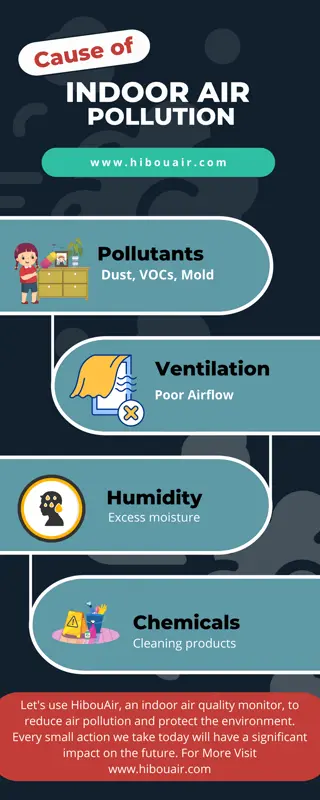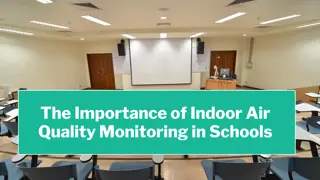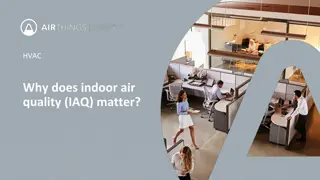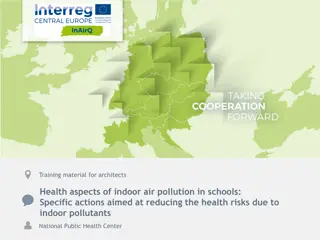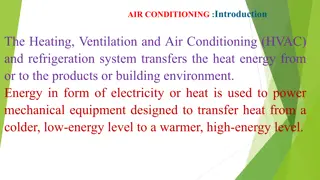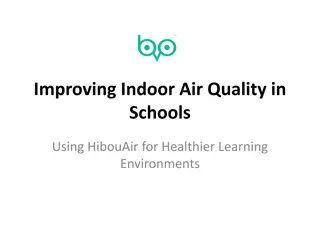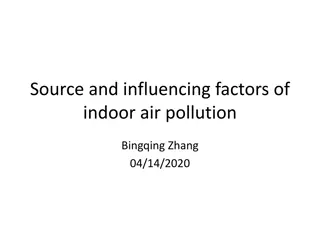Importance of Indoor Air Quality for Schools and Buildings
Sustainable Jersey for Schools emphasizes the significance of maintaining good Indoor Air Quality (IAQ) in educational facilities. Proper ventilation and sunlight are essential for creating a conducive environment for learning. Neglecting IAQ can lead to health issues and hinder students' and teachers' performance. The EPA defines IAQ based on air temperature, humidity, ventilation, and air contaminants, highlighting its impact on health, comfort, and productivity. Poor IAQ in schools can result in increased absenteeism due to asthma-related illnesses and hinder students' ability to concentrate and learn effectively.
Download Presentation

Please find below an Image/Link to download the presentation.
The content on the website is provided AS IS for your information and personal use only. It may not be sold, licensed, or shared on other websites without obtaining consent from the author. Download presentation by click this link. If you encounter any issues during the download, it is possible that the publisher has removed the file from their server.
E N D
Presentation Transcript
SUSTAINABLE JERSEY FOR SCHOOLS Sustainable Jersey for Schools is a certification program for New Jersey public schools that want to go green, conserve resources and take steps to create a brighter future, one school at a time Actions related to Indoor Air Quality: IAQ Review Process for reporting IAQ issues Classroom Cleanup protocols & practices
Perspective In the construction of buildings, whether for public purposes or as dwellings, care should be taken to provide good ventilation and plenty of sunlight .schoolrooms are often faulty in this respect. Neglect of proper ventilation is responsible for much of the drowsiness and dullness that .make teacher s work toilsome and ineffective.
Perspective In the construction of buildings, whether for public purposes or as dwellings, care should be taken to provide good ventilation and plenty of sunlight .schoolrooms are often faulty in this respect. Neglect of proper ventilation is responsible for much of the drowsiness and dullness that .make teacher s work toilsome and ineffective. -Health Reformer, 1871
Did You Know.. Americans spend 90% of their day indoors-in classrooms, offices, and at home. 90% of schools in the U.S. were built before 1980, and 50% of those before 1960. Studies have indicated that indoor air often 5 to 10x dirtier and contain higher levels of contaminants than outdoor air.
Did You Know.. Nearly 60 million students, and staff attend/work in our nation s schools, representing about 20% of the population. Recent data suggests that poor indoor air quality may directly reduce a person s ability to perform specific tasks requiring concentration, calculation, or memory. Asthma-related illnesses among students and staff is one of the leading causes of school absenteeism, accounting for 14 million missed school days per year.
What is Indoor Air Quality(IAQ)? The Environmental Protection Agency(EPA) defines Indoor Air Quality(IAQ) as: The temperature, humidity, ventilation and chemical or biological contaminants of the air inside a building. IAQ refers to the quality of the air inside buildings as represented by concentrations of pollutants and thermal (temperature and relative humidity) conditions that affect the health, comfort, and performance of occupants.
What is the significance of Indoor Air Quality(IAQ)? 'A' is for air. People breathe air--REGULARY! That alone makes IAQ a pretty important topic. Most adults probably have a basic awareness that inhaling mold, mildew, asbestos, harsh chemicals, and other pollutants can have adverse health effects, especially for one's respiratory system.
What is the significance of Indoor Air Quality(IAQ)? Growing children with developing lungs are especially sensitive to toxic environmental pollutants. School-based exposure to poor IAQ can interfere with a student's ability to be present, ready, and able to learn. Asthma, headaches, lethargy, nausea, drowsiness, and dizziness can be distracting. Beyond producing acute symptoms and irritations, certain hazardous pollutants--referred to as 'air toxics'--are known or suspected to cause cancer over time.
Consequences of Poor IAQ? Increased potential for short and long term health issues. Decreased comfort, performance, and attendance. Accelerated deterioration and reduced efficiency of buildings and equipment. Increased potential for school closings/relocations. Strained relationships-Administration, staff, and parents. Negative publicity, decreased community trust, liability problems.
When did poor IAQ become a noticeable problem? As a result of the energy crisis of the mid-1970s, IAQ complaints on the workplace dramatically increased for several reasons: The tendency toward tighter building envelopes and reduced ventilation to save energy. The growing proliferation of chemical pollutants in consumer and commercial products. Pressures to defer maintenance and other building services to reduce costs.
What Affects IAQ? IAQ is not necessarily an easily understood concept. It is a constantly changing interaction of a complex set of factors. Problems occur in many types of buildings. Problems reflect both comfort and health related issues. Primary sources of IAQ problems include: Ventilation Contaminants generated indoors Infiltration of outdoor contaminants Unidentified sources
What Affects IAQ? Ventilation Systems(HVAC) Mechanical heating, ventilating, and air- conditioning equipment: Designed to control indoor temperatures by supplying heated and cooled air. Dilute and remove airborne contaminants by providing a continuous supply of filtered outdoor air. Systems are designed to maintain a slight positive pressure in the building.
Basic Ventilation System 100% Supply Air 10% Outside Air 90% Recycled Air Ventilated Space 10% Exhausted Air 100% Return Air
What Affects IAQ? Indoor Contaminant Sources: Dust and Dirt CO2 (Primarily from Occupants) Perfumes, Colognes, Air-Fresheners Cleaning/Disinfecting Products Plants and Flowers Off gassing of new materials Mold (From intrusion of moisture) Stale air from unventilated areas Science and Art Supplies Rodent and Insect Activity
What Affects IAQ? Outdoor Contaminant Sources: Exhaust vents located near make-up air intakes Vehicles idling near open windows and doors* *District anti-idling policy pending Pollen from outdoor plants Pollution from nearby facilities and construction Infiltration of general outdoor contaminants
What is Acceptable IAQ? The American Society of Heating Refrigeration and Air conditioning Engineers, Inc. (ASHRAE) defines Acceptable Indoor Air Quality as: Air in which there are no known contaminants at harmful concentrations as determined by authorities and at which a substantial majority (80% or more) of the people exposed do not express dissatisfaction.
What is Acceptable IAQ? Buildings exist to protect people from the elements and to otherwise support human activity. Buildings should not make people sick, cause them significant discomfort, or otherwise inhibit their ability to perform. However it must be understood that not all occupants may be "satisfied" with how effectively a building functions.
Health Effects of IAQ Varied and non-specific Health and comfort related: Personal temperature/humidity level preference Sensitivities to chemical or biological contaminants Unrelated health issues or stress Air monitoring does not always support their existence
Health Effects of IAQ Sick Building Syndrome-Building occupants experience acute health and comfort effects that are apparently linked to the time working indoors. Building-Related Illnesses-A relatively small number of occupants experience health problems accompanied by physical signs that are identified by a physician and/or laboratory findings, and can be attributed to environmental agents in the air.
Sick Building Syndrome (SBS) vs. Building-Related Illness (BRI): Sick Building Syndrome Symptoms: Building-Related Illness Symptoms: Headaches Eye, nose, throat, and upper respiratory tract irritation Eye, nose, throat irritation Dry or itchy skin Skin irritation or rashes Fatigue Chills, fever, cough, chest tightness, congestion, sneezing, runny nose Dizziness Nausea Muscle aches Loss of concentration
Sick Building Syndrome (SBS) vs. Building-Related Illness (BRI): Sick Building Syndrome Symptoms: Do not fit the pattern of any particular illness Building-Related Illness Symptoms: Physical signs of exposure to chemical or biological substances Relief from illness may not occur upon leaving the building Difficult to trace to a specific source Relief occurs upon leaving the building
Building-Related Illness: Hypersensitivity Pneumonitis Asthma Chemical Sensitivity Legionnaires Disease
How does the Facilities Department manage IAQ? Proactive Element Preventive maintenance on buildings and equipment Proper cleaning procedures and practices Department Personnel and Staff Awareness Training Reactive Element Prompt evaluation and correction of building and equipment breakdowns. Investigation of all IAQ concerns/complaints to resolve issues. Compliance Element Adherence to all local, state, federal standards and laws relating to IAQ in schools.
PEOSH IAQ Standard N.J.A.C. 12:100-13 et seq. PEOSH-Public Employee Occupational Safety and Health Enforced by NJDOHSS/NJDOL Adopted in 1998, First IAQ Standard in U.S. Revised in 2007, PEOSH Advisory Board, IAQ Subcommittee Designated Person Written IAQ Program 48 Hrs to remove damp materials
PEOSH IAQ Standard N.J.A.C. 12:100-13 et seq. 13.1 Scope 13.2 Definitions 13.3 Compliance Program 13.4 Control of Specific Contaminant Sources 13.5 Air Quality During Renovation & Remodeling 13.6 Recordkeeping 13.7 Employer s Response to Complaints 13.8 IAQ Compliance Documents
PEOSH IAQ Standard N.J.A.C. 12:100-13.1 Scope: This subchapter shall apply to matters relating to indoor air quality in buildings occupied by public employees during regular work hours.
PEOSH IAQ Standard N.J.A.C. 12:100-13.2 Definitions (selected): "Designated person" means a person who has been given the responsibility by the employer to take necessary measures to assure compliance with this subchapter. "Office building" means a building in which administrative, clerical or educational activities are conducted. Examples of facilities and/or operations, which are not office buildings, include repair shops, garages, print shops and warehouses.
PEOSH IAQ Standard N.J.A.C. 12:100-13.2 Definitions (selected): HVAC system" means the collective components of the heating, ventilation and air-conditioning system including, but not limited to, filters and frames, cooling coil condensate drip pans and drainage piping, outside air dampers and actuators, humidifiers, air distribution ductwork, automatic temperature controls, and cooling towers. "Renovation and remodeling" means building modification involving activities that include but are not limited to: removal or replacement of walls, roofing, ceilings, floors, carpet, and components such as moldings, cabinets, doors, and windows; painting; decorating; demolition; surface refinishing; and removal or cleaning of ventilation ducts.
PEOSH IAQ Standard N.J.A.C. 12:100-13.3 Compliance Program: Employer shall identify and train a Designated Person A person given the responsibility (and authority) by the employer to take measures to assure compliance
PEOSH IAQ Standard N.J.A.C. 12:100-13.3 Compliance Program: Employer s designated person shall: Establish and follow a preventative maintenance schedule Ensure that damaged or inoperable components are replaced or repaired promptly Implement the use of general or local exhaust ventilation Check the HVAC system when carbon dioxide levels exceed 1,000 ppm
PEOSH IAQ Standard N.J.A.C. 12:100-13.3 Compliance Program Employer s designated person shall: Check HVAC system if temperature range is outside 68 F-79 F Prevent contamination of fresh air supply Check that natural ventilation portals are maintained Promptly investigate all employee concerns/complaints about IAQ Prepare written plan (including required components) Review and update written plan annually
PEOSH IAQ Standard N.J.A.C. 12:100-13.4 Control Specific Indoor Contaminants Microbial Contaminants Promptly repair water intrusion that can promote biological growth Remediate damp/wet material by drying or removal within 48hrs of discovery and continue until water intrusion is eliminated Remove visible microbial contamination
PEOSH IAQ Standard N.J.A.C. 12:100-13.5 Renovation and Remodeling: Evaluate chemical hazards Notify employees 24 hours prior to any construction Utilize local exhaust ventilation Isolate construction areas (scheduling, physical barriers, pressure differentials) Construction areas required to be cleaned and aired out as necessary prior to re-occupancy
PEOSH IAQ Standard N.J.A.C. 12:100-13.6 Recordkeeping Required Records Written IAQ Program Documentation of Designated Person Training Written Preventive Maintenance Program Preventive Maintenance Log
PEOSH IAQ Standard N.J.A.C. 12:100-13.6 Recordkeeping Requirements: Maintained for 3 years Available to employees and representatives for examination and copying ASAP or within 10 working days Available immediately during PEOSH inspection
PEOSH IAQ Standard N.J.A.C. 12:100-13.7 Employer s Response to Signed PEOSH Complaint: PEOSH will send letter to employer for a response: Designated Person will respond within 15 days Provide statement that the complaint is NOT founded and/or Study of Issue initiated and completion date Remediation measures already completed Remediation planned and completion time
PEOSH Program Response to Unacceptable IAQ On-site Inspection Conduct Employee Interviews Review Building Operations & Maintenance Procedures Walk-through inspection of the building Inspect HVAC System Review As-builts construction plans of the building Conduct Air Sampling, if necessary Complete PEOSH IAQ Checklist Remediation Plan, follow up re-inspections
PEOSH IAQ Standard N.J.A.C. 12:100-13.8 IAQ Compliance Documents As-built construction documents HVAC System Commissioning Report HVAC Systems Testing, Adjusting, and Balancing Reports Operations and Maintenance Manuals Water Treatment Logs Operator Training Materials Must be provided to PEOSH, upon request (if available)
Other Standards Related to IAQ (Overview) PEOSH General Industry (29 CFR 1910.1001) and Construction (29 CFR 1926.1101) Asbestos Standards Identification of asbestos-containing materials in all buildings (pre-1980) Labeling and signage requirements Annual awareness training Notification of outside contractors Other Federal and State Asbestos Standards Schools (AHERA)-U.S. EPA/NJDHSS NJ Uniform Construction Code-Subchapter 8, NJ Dept. of Community Affairs (NJDCA)
Additional IAQ Resources PEOSH Publications http://nj.gov/health/peosh/iaq.shtml Public Employer s Guide and Model Written Program for the Revised Indoor Air Quality Standard PEOSH Policy on Building Renovations Information Bulletin Renovation & Construction in Schools-Controlling Health and Safety Hazards Information Bulletin Bioaerosols Information Bulletin Mold in The Workplace, Prevention and Control Information Bulletin
How can staff assist with IAQ? There are some things that, teachers, staff, and other personnel can do to help improve the indoor air quality in our classrooms and school. Recognizing that proper building maintenance is a school department function, there are some suggestions that we d like to offer to help enhance those efforts.
How can Staff assist with IAQ? Ventilation: Allow ventilation units to run continuously, keeping grilles and diffusers clear of obstructions. Keep thermostats clear of obstructions or heat generating equipment. Promptly report any ventilation equipment related issues( noises, odors, temperature control, air-flow problems, comfort). Potential Contaminants: Do not bring in or use cleaning products, air fresheners, candles, pesticides from home. Promptly report water leaks, moisture on surfaces, mold, pest activity. Cleanliness: Store loose items in containers to reduce clutter in the classroom. If possible, limit the use of upholstered furniture, throw pillows, stuffed animals as they collect dust. Ensure that spills(especially on carpets) are cleaned promptly.
How can Staff report an IAQ concern? Fill out IAQ Concern Form and send to Facilities Manager Forms are available in the main office of each building, and on the Facilities page of the school website. Regardless of how minor the concern may be, it will be investigated Follow up Investigation by Facilities Manager Go to the location(s) of concern Conduct interviews Review building operations and maintenance procedures Complete PEOSH IAQ Inspection/Walkthrough Checklist Involve employees through PEOSH if needed Communicate outcome and corrective action
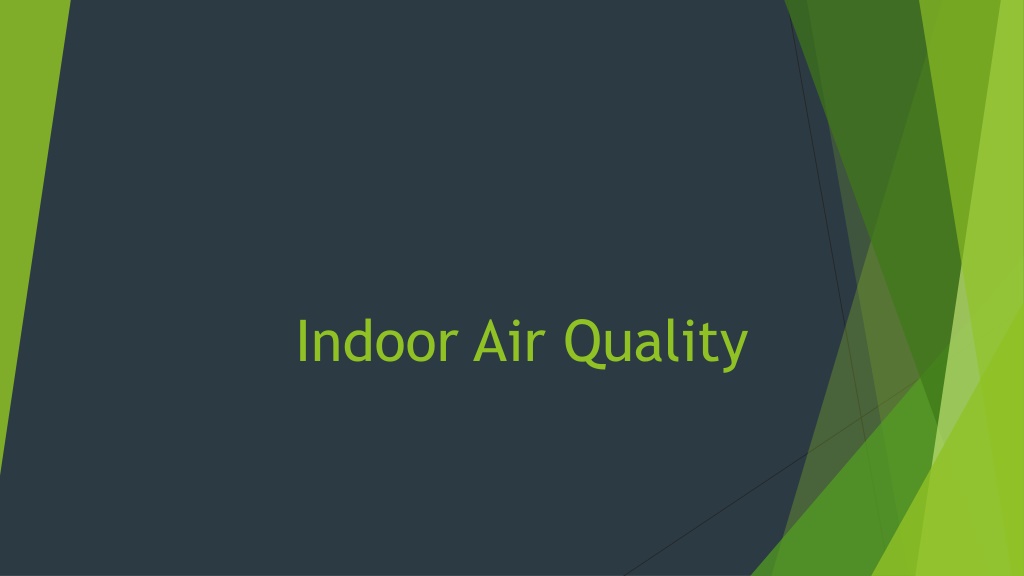
 undefined
undefined







